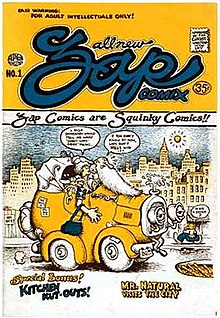Underground comics
| Underground comix | |
|---|---|

The cover artwork for the first issue of Zap Comix, featuring the character Mr. Natural.
|
|
| This topic covers comics that fall under various genres. | |
| Publishers |
Apex Novelties Kitchen Sink Press Last Gasp Print Mint Rip Off Press |
| Publications |
Zap Comix Arcade Bijou Funnies Fabulous Furry Freak Brothers Wimmen's Comix |
| Creators |
R. Crumb Kim Deitch Spain Rodriguez Gilbert Shelton S. Clay Wilson |
| Related articles | |
| Alternative comics | |
Underground comix are small press or self-published comic books which are often socially relevant or satirical in nature. They differ from mainstream comics in depicting content forbidden to mainstream publications by the Comics Code Authority, including explicit drug use, sexuality and violence. They were most popular in the United States between 1968 and 1975, and in the United Kingdom between 1973 and 1974.
Robert Crumb, Gilbert Shelton, and numerous other cartoonists created underground titles that were popular with readers within the counterculture scene. Punk had its own comic artists like Gary Panter. Long after their heyday underground comix gained prominence with films and television shows influenced by the movement and with mainstream comic books, but their legacy is most obvious with alternative comics.
Between the late 1920s and late 1940s, anonymous artists produced counterfeit pornographic comic books featuring unauthorized depictions of popular comic strip characters engaging in sexual activities. Often referred to as Tijuana bibles, these books are often considered the predecessors of the underground comix scene. Early underground comix appeared sporadically in the early and mid-1960s, but did not begin to appear frequently until after 1967. The first underground comix were personal works produced for friends of the artists, in addition to reprints of comic strip pages which first appeared in underground newspapers.
The United States underground comics scene emerged in the 1960s, focusing on subjects dear to the counterculture: recreational drug use, politics, rock music and free love. These titles were termed "comix" in order to differentiate them from mainstream publications. The "X" also emphasized the X-rated contents of the publications. Many of the common aspects of the underground comix scene were in response to the strong restrictions forced upon mainstream publications by the Comics Code Authority, which refused publications featuring depictions of violence, sexuality, drug use and socially relevant content, all of which appeared in greater levels in underground comix. The underground comix scene had its strongest success in the United States between 1968 and 1975, with titles initially distributed primarily though head shops. Underground comix often featured covers intended to appeal to the drug culture, and imitated LSD-inspired posters to increase sales. Crumb stated that the appeal of underground comix was their lack of censorship: "People forget that that was what it was all about. That was why we did it. We didn't have anybody standing over us saying 'No, you can't draw this' or 'You can't show that'. We could do whatever we wanted."
...
Wikipedia
